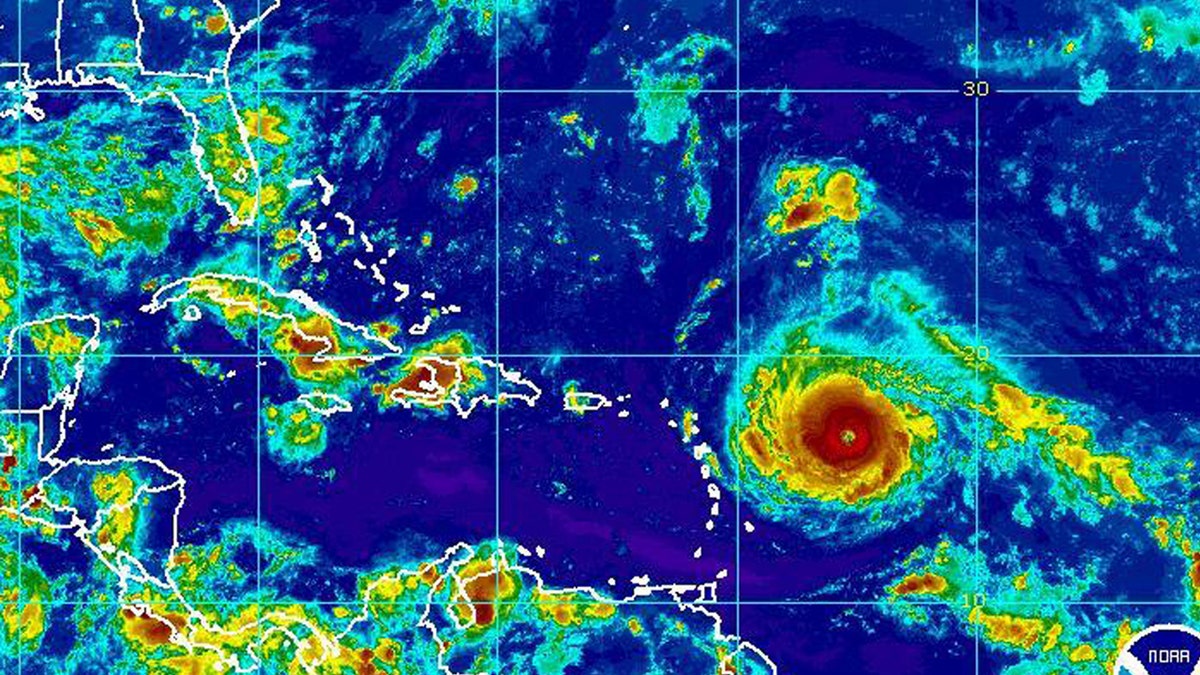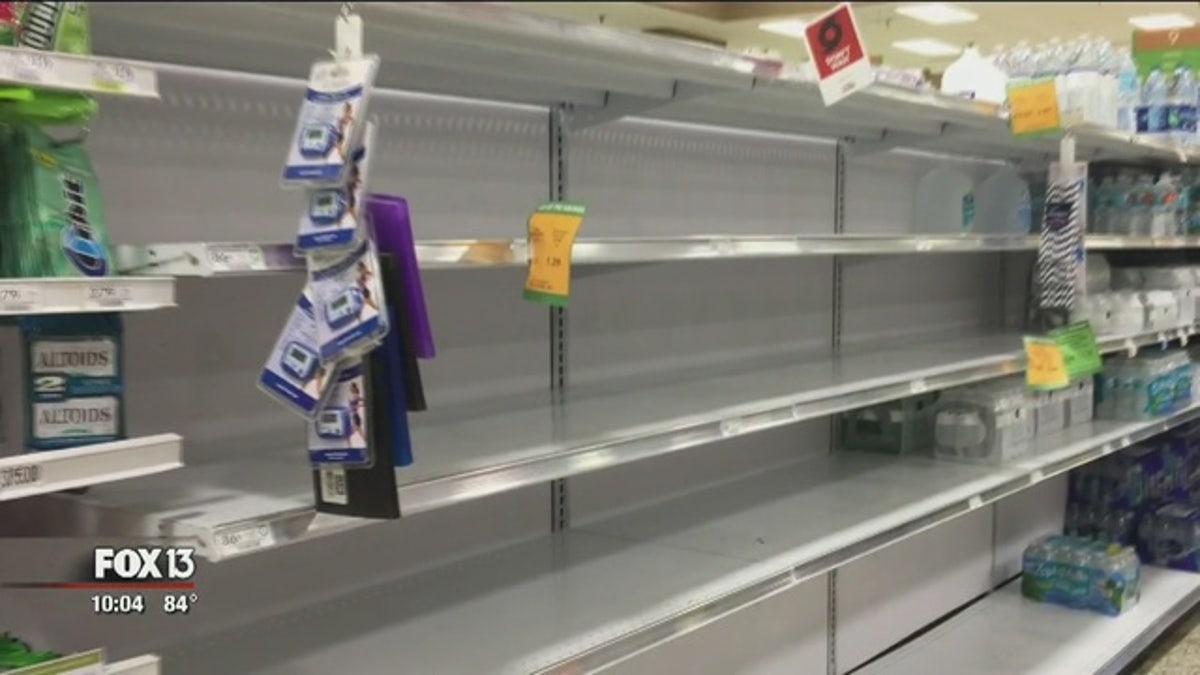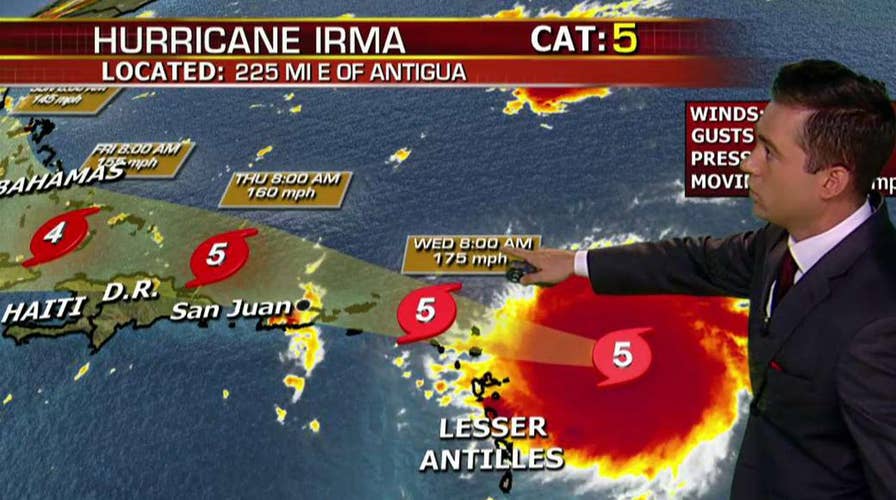Steering winds key to powerful Hurricane Irma's path
Hurricane watches and warnings stretch across Caribbean islands; Adam Klotz reports from the Fox Extreme Weather Center
Hurricane Irma continued to strengthen Tuesday as an "extremely dangerous" Category 5 storm, prompting states of emergency in Puerto Rico, the U.S. Virgin Islands and Florida -- with the powerful storm forcing evacuations in the Florida Keys.
Irma's maximum sustained winds had increased to near 185 mph, and the storm was located about 180 miles east of Antigua, moving west at 14 mph, the National Hurricane Center said in its 2 p.m. ET advisory.

This Monday, Sept. 4, 2017, satellite image provided by the National Oceanic and Atmospheric Administration shows Hurricane Irma nearing the eastern Caribbean. (NOAA via AP)
"Some fluctuations in intensity are likely during the next day or two, but Irma is forecast to remain a powerful category 4 or 5 hurricane during the next couple of days," the NHC said.
Irma's center was expected to move over portions of the northern Leeward Islands late Tuesday and early Wednesday, and the storm's eye was then expected to pass about 50 miles from Puerto Rico late Wednesday.
Fox News Senior Meterologist Janice Dean said Irma is now "one of the strongest hurricanes we have witnessed in the last decade."
Outside of the Caribbean and Gulf of Mexico, the NHC said Irma is the strongest hurricane in the history of the Atlantic basin according to agency records.
Hurricane warnings were issued for 12 island groups in the Caribbean, including the British Virgin Islands, where the governor urged those who could to evacuate the tiny island of Anegada ahead of the storm.
TRACK HURRICANE IRMA AT MYFOXHURRICANE.COM
Irma is the strongest Atlantic hurricane since Rita in 2005, officials said. “Puerto Rico has not seen a hurricane of this magnitude in almost 100 years,” Carlos Anselmi, a National Weather Service meteorologist in San Juan, told The Associated Press.
"Florida and the Southeast U.S. should be paying close attention to the forecast and any changes over the coming days, while South Florida and the Florida Keys should be preparing for potential impacts from a dangerous Category 4 hurricane this weekend."
The forecast for Irma remains tricky during the weekend as it approaches South Florida Saturday night into Sunday. The storm is expected to make a sharp turn to the north as a trough moves into the region, according to Dean.
"Florida and the Southeast U.S. should be paying close attention to the forecast and any changes over the coming days, while South Florida and the Florida Keys should be preparing for potential impacts from a dangerous Category 4 hurricane this weekend," she said.
Puerto Rico Gov. Ricardo Rossello warned that all decisions made in the next couple of hours could make a difference between life and death.
Authorities warned the storm could dump up to 10 inches of rain on parts of the Caribbean, cause landslides and dangerous flash floods and generate waves of up to 23 feet.
"This is not an opportunity to go outside and try to have fun with a hurricane," U.S. Virgin Islands Gov. Kenneth Mapp warned. "It's not time to get on a surfboard."
While Irma's potential impact on the U.S. mainland is not yet fully known, Florida Gov. Rick Scott declared a state of emergency Monday to ensure "local governments have ample time, resources and flexibility to get prepared for this dangerous storm."
"In Florida, we always prepare for the worst and hope for the best and while the exact path of Irma is not absolutely known at this time, we cannot afford to not be prepared," Scott said in a statement.
FLORIDA GOV. RICK SCOTT DECLARES STATE OF EMERGENCY AHEAD OF HURRICANE IRMA
Scott activated 100 Florida National Guard members Tuesday to assist with preparing for Irma, while officials issued mandatory evacuations for visitors and residents of the Florida Keys.
Monroe County officials said a mandatory visitor evacuation is expected to begin at sunrise on Wednesday. An evacuation for residents also will be issued, though a time has not yet been set.
Officials strongly encouraged tourists and residents to start evacuation plans now, and said the earlier people leave the Keys, the less traffic they were likely to encounter.
“If ever there was a storm to take seriously in the Keys, this is it,” Monroe County Emergency Management Director Martin Senterfitt said in a statement. “The sooner people leave, the better.”
U.S. 1 was the only route in and out of the island chain off the southern peninsula of Florida.

Some supermarkets in the Tampa Bay area ran low on water Monday. (FOX 13 Tampa)
Some residents across South Florida spent Labor Day stocking up on supplies in case Irma nears, instead of buying items for barbecues.
“Obviously, get ready ahead of time. We have food, as you can see," shopper Jacqueline Kimbrough told WSVN of her preparations. "We have our music. We just have a good time. We don’t worry about it and we pray."
People across South Florida were spending Tuesday stocking up on supplies, causing many stories to run out of water and generators, WSVN reported.
Customers at a Costco in Miami Lakes were lined up outside the wholesale store until the moment doors opened up at 10 a.m., and lines snaked throughout the store.
Further north on Florida's Gulf Coast, residents weren't taking any chances, and spent Monday making sure their disaster kits are ready for whatever the storm brings.
"Definitely better now than when it's too late," Chance Burnett told FOX 13 Tampa as he loaded cases of water bottles into his trunk.
"We've got a lot of cases of water and a lot of canned foods, tuna, Chef Boyardees," said Burnett. "And then, we are on our way to Home Depot and we are going to stock up on flashlights and batteries."

Some residents across Florida spent their Labor Day getting supplies in case Hurricane Irma nears. (FOX 13 Tampa)
At Home Depot in Tampa, tarps, gas containers and generators were among the most popular items being bought by shoppers. The generator shelves were restocked on Monday morning, but were already sold out by the afternoon.
Assistant store manager Chrissy Lenze told FOX 13 the store expects a new shipment this week, and they have plenty of other supplies.
"Mostly plywood, water, flashlights, tarps for afterwards, sandbags to prepare," Lenze said. "We want to be the last ones to close, first ones to open during a storm."
On Puerto Rico, which will feel Irma's effects by Wednesday, residents braced for electricity outages after the director of the island's power company said that storm damage could leave some areas without electricity for four to six months.
Ricardo Ramos told radio station Notiuno 630 AM "some areas will have power [back] in less than a week." The utility's infrastructure has deteriorated greatly during a decade-long recession, and Puerto Ricans experienced an island-wide outage last year.
Both Puerto Rico and the U.S. Virgin Islands expected 4 inches to 8 inches of rain and winds of 40-50 mph with gusts of up to 60 mph.
The last Category 5 storm to hit the United States was Hurricane Andrew in 1992. An estimated 250,000 were left homeless and the storm caused more than $20 billion in damage in the Bahamas, Florida and Louisiana. Fifty-five people were killed.
The Associated Press contributed to this report.





















